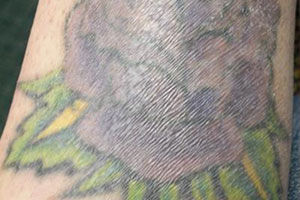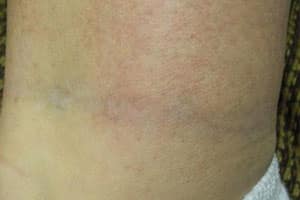Time to Undo That Tattoo?
Tattoo Removal in Boston, MA
Decorative tattoos have a history dating back from ancient times. Currently, almost twenty percent of people in the United States have tattoos and the number is still growing. For the younger generation, tattoos are considered a symbol of freedom, but with advancing age, more and more wish to remove them because of the negative connotation associated with tattoos. Tattoos are also removed simply because of an individual’s desire to replace the existing tattoo with a newer design.
Tattoo Removal Before and Afters


How does Tattoo Removal Work
Removal of tattoos depends on the principle of selective photothermolysis; when the proper wavelength is applied the ink absorbs the energy preferentially, causing it to break down. The body’s natural healing processes remove broken down pigment over time. Surrounding tissue is largely unaffected, but not entirely spared, so tattoo removal is typically uncomfortable for patients. Numerous sessions are required to maximize results.
Laser Tattoo Removal FAQs
Medical lasers use a beam of light to significantly lighten or completely remove your tattoo. When the ink particles absorb the light from the laser, they are broken up into fragments and then absorbed through your body’s immune system. This process generally takes a few weeks. The larger the tattoo, the more sessions it will take to break down the ink particles.
Occasionally, a whitening of the skin may occur. However, normal skin tone should return within 6 -12 months following your last treatment session. Since the ink used in tattooing can vary from tattoo to tattoo, some patients have only partial clearing even after several sessions.
Right after your treatment, your skin will have a white discoloration, and the area around the tattoo may become reddish and appear swollen. This is normal and will disappear slowly over time. Results take about 5 weeks after each treatment. Immediately after treatment, antibacterial ointment and gauze will be applied to the treated area to minimize infection.
Before the advent of the medical laser, common techniques included cryosurgery, dermabrasion or excision. These methods can be painful and may often result in scarring. Laser treatments are safer. They are minimally invasive and only target the ink used in the tattoo process. Lasers are now the modern standard for tattoo removal, specifically the Q-switched laser.
Some patients say they feel a slight sting, like the snap of a rubber band on the skin. Many treatments do not require anesthetics. However, some patients feel more comfortable with a local numbing agent, such as a topical anesthetic.
The number of treatments required for optimal results depends on the size, location, depth and color of the tattoo. Treatment should be performed 4 – 8 weeks apart in order to allow the body to remove the maximum amount of tattoo pigment after each treatment.
Each session usually takes 10 – 30 minutes. You will continue to see lightening of your tattoo after each treatment as your body disposes of more pigment. Most patients will see improvement in their tattoos and results can be quite dramatic.
Schedule your Laser Tattoo Removal Consultation
Have a tattoo you’re ready to kiss goodbye? Schedule your consultation at Regeneris Medspa & Cosmetic Surgery in Boston, MA, to discuss if laser tattoo removal is the right solution for you.